#muse: kuromatsu
Note
Would Kuromatsu date Sanae and vice versa?
You'll have to forgive the lack of icons here - Kuromatsu has none at the moment.
"Me and the Moriya Shrine maiden?" she'd echo, pointing at herself in a mix of confusion and surprise. "I... I don't know about that. I mean, I've only ever met her once or twice... she was nice enough but I don't think she'd be interested. Not to mention what my parents would think... I mean, maybe? I don't think it'd happen though."
=================================

"Kuromatsu, Kuromatsu..."
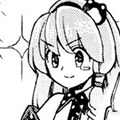
"Oh! I remember her. The white wolf tengu with the black hair. She is cute, isn't she? I don't know if I know her well enough to say whether I'd date her. But at least she's got the right look. Though... well, lots of people in Gensokyo have the right look. I'd have to know her better before I could say anything."
#muse: sanae#muse: kuromatsu#nyalternatehellkitten#holy hell someone remembered Kuromatsu#not even I do that sometimes
3 notes
·
View notes
Text
Bleach - Name Games
Continuing with the zanpakutou posts... One that seemed to get broadly misinterpreted is,
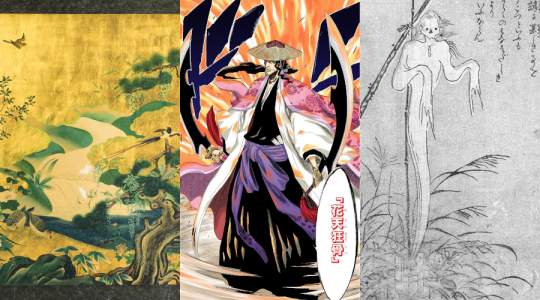
Katen Kyokotsu(花天狂骨)
...written as 花: “Flower,” 天: “Heaven,” 狂: “Madness,” and 骨: “Bone.” Viz translated this as "Flower-Heaven Bone of Madness," and later changed it to “Flower Crazed Heaven Bone Spirit.” But what I keep seeing overlooked is that Kyoukotsu(狂骨) is the name of a youkai; a white haired elderly man emerging from a well to act upon a grudge, cursing people who would drink from its well. (It’s also a homonym with the word for Kyoukotsu(胸骨) “Sternum” written “Breast”+”Bone” which is played on in Kyokotsu’s design for the anime as a skull-clad busty woman.) “Bone-Spirit” actually does seem like it’s referring to the youkai, but then it scrambles up all the other adjectives and nouns.
Kyoukotsu(狂骨) is also a slang term in some regions for someone in a state of looking wild and and in noisy disarray --which basically refers to either a a mentally unstable person, or a raucous drunkard. I think the logic in that might have to do with the idea of the Kyoukotsu cursing its well, and the idea that a belligerent or gibbering drunk being that way from having drank something evil... i.e. from a cursed well? Given the nature of zanpakutou as reflections of their wielders’ inner-selves and Kyouraku’s disposition as a frivolous drinker, it may have been meant to imply a darker side to that.
I’ll be honest, I can’t tell if Katen is supposed to evoke “A Flower (from) Heaven” or “A Heaven (made/full of) Flowers.” They more or less imply the same tone, but it’s the difference between a singular item or a whole landscape. The only more specific phraseology I can find that would point in one direction over any other is katengecchi(花天月地) which refers to a scene of flowers blooming in moonlight, and kind of makes me lean more toward the landscape imagery of a field of flowers so beautiful that it is like heaven. But I don’t know that those terms are even really related.
Together, at least to me, it seems to give off the impression of getting sloppy drunk in a field of flowers, which seems pretty in line with his general vibe.
But adding to these themes, his release call is notably longer than most, and appears to be specifically split up into one call for each of his two identical swords (and Ukitake’s the same, but noticeably Ukitake’s sword can’t be interpreted as two different names, like what they did with Katen and Kyoukotsu). These and Ukitake’s, more than any other zanpakutou calls, and more like the hadou spells, lean into Kubo’s affinity for poetry --something he also indulges in in his tankobon poems.
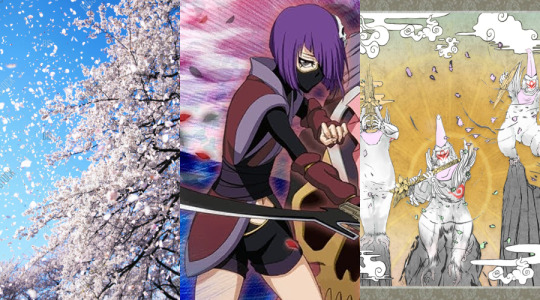
花風紊れて, 花神啼き: “Flower-Wind* in disarray, Flower-spirit(s) call out/cry/wail”
*I think... think... maybe... this is supposed to be an abbreviated form of Kachou-Fuugetsu(花鳥���月), written “Flower, Bird, Wind, Moon” which is a term used in classical Japanese art to refer to “the beauty of nature” as subject matter. It doesn’t have to literally include Flowers, Birds, the Wind, or the Moon. Basically, it just refers to a nature scene meant to display the beauty of nature (as opposed to being a slice of life or a strictly historical depiction, or other non-aesthetic-primary focus.)
Also the construction Kashin(花神) here written as “Flower kami*” doesn’t seem to refer to a specific deity, but worth noting is that it’s a homonym with Kashin(歌神): the kami* of Waka and of song --Waka being a traditional Japanese form of poetry, which are also sometimes translated as “muse” if that gives you a better sense of what they are. Functionally they are closely related, because it’s the spirit of nature that inspire poetry/song about the beauty of said nature. Moreover, as discussed previously, Shunsui has a distinct theme of both flowers and of music, so both feel kind of relevant here.
*I feel like this is kind of a Japanese mythos 101 thing to point out, but if you’re not aware, Shinto being an animist religion means they believe in an innate spirit in basically all things. The word kami does not mean “god,” it refers broadly to that innate spirit that all things possess. The most powerful kami are analogous to gods in other religions, but a kami’s only real definitive quality is that it is a spirit and that is exists... the spirit of a flower has no power nor grand design nor will, nor any other quality that would make sense attributing to what we call a “god” in the West. But that doesn’t make it any less a kami.
Also the naki(啼き) here is the same root as the nake(啼け) that Urahara and Benihime uses. It can, in this context, read like “yelps” or “wails” or even “screams” but all in the tone of, “cries of distress.” (As opposed to quiet weeping; it’s “cry” as in the sound, not the tears.)
Also it’s kinds awkward but the verb midarete(紊れて) is the conjunctive form of the verb “to disturb” but I don’t know how to say that in English without throwing a lot of extra words into it, and I didn’t want to imply that there were more words and their implicit meaning involved.
And then...
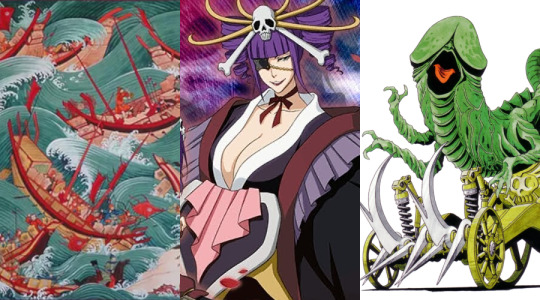
天風紊れて, 天魔嗤う: “Heaven-Wind in disarray, Tenma* laughs/sneers/ridicules”
I feel like “Heavenly Wind” here is supposed to refer to something more specific than just the two words mashed together, but I can’t really find anything that clarifies this for me... But my first assumption is that like kamikaze(神風) “Divine Wind” it’s meant to describe a favorable wind, sent to protect or relieve someone in need; hence it being “spoiled,” “thrown about,” or “dispersed” being a bad thing, in the same tone as the Flower-Wind phrase above. It’s the same verb, but i feel like “disarray” of something like “a wind” doesn’t visualize clearly.
And the specific term Kamikaze went from a general term to a specific title to refer to the two notable historic typhoons that coincidentally sank invading Mongolian fleets in the 13th century. For their immense power and convenient timing they were attributed to acts of the divine defending Japan. In turn it’s why the Japanese kamikaze pilots of WWII were so named.
*Tenma is the Japanese name of the Hindu Mara, of Buddhist mythos. He is a kind of temptor figure presiding over both lust and desire as well as hesitation and fear such that they interfere with a buddhist's ability to meditate, focus, and adhere to their virtues. In particular he's responsible for having tempted Siddharta Gautama Buddha with beautiful women. (in some iterations said to be the deva's own daughters.)
Yes, it’s the same Mara as the SMT franchise, but the giant penis monster Mara isn’t based on any real mythology, it’s actually a pun on the Japanese Mara(摩羅), written as “chafe/rub/polish/grind (against) thin-silk,” and used as a term meaning “obstacle to Buddhist practice” in accordance with the actual Hindu Mara’s role in mythology. I’ll be honest though, I don’t know if the construction is supposed to reference masturbation or dry humping. Maybe both?
So, trying to work all this into something a little more readable in English, what I think the overall vibe of this is, is...
“The-Beauty-of-Nature is being thrown into disarray, and the Flower-spirits wail; Saving-Graces aren’t going to arrive, and ‘The Devil’ laughs(mockingly).”
The theme here is that the beauty of nature suffers, a heavenly blessing is interrupted, and a demonic figure laughs at it: There’s nothing to sing about, there’s no relief, the tempter wins. It’s actually a little weird because thematically it feels very much the opposite of what his shikai actually does. I feel like he wanted Shunsui using his shikai to be that moment of serious-ing up, but by the time he came back around to actually using it, he wanted to keep Shunsui’s powers more in line with his personality and save the change of mood for his big bankai reveal instead. but we’ll get to that in a bit...
For context, Kyouraku Shunsui’s own name reading as “Capital(City) Music, Flower Water” points to his lazy personality: he’s a big city type who’s all about lounging and luxury and sweet indulgences. So, his sword release by contrast is those declaration that playtime is over, Kyoraku is done being lazy.
Broadly speaking I never really liked Masashi Kudou’s anime-original designs for most of Bleach’s filler arcs, other than just not really aesthetically fitting with Kubo’s design sensibilities(all Kudou’s designs look like bad cosplay with big swatched of empty solid space, flat colors, no color balance, and no implicit weight or texture) they don’t really gel with most of their names and themes, but Katen Kyoukotsu in particular got kind of tragically reduced to a generic waifu design. I honestly really hate that Kubo went and ran with that design for Shunsui’s bankai.
And speaking of bankai...
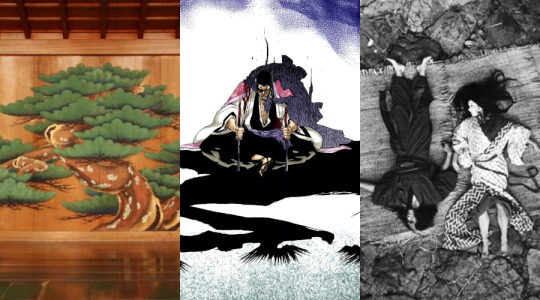
Karamatsu Shinjuu(枯松心中)
is tacked onto the end of the same name as the shikai to make the new bankai name. Kara(枯) and matsu(松) just read as “Withered/Withering PineTree.” Fun fact: when chapter 647 first ran in Weekly JUMP, the title was Kuromatsu(黒松) which is the specific species of “Japanese Black Pine,” Pinus thunbergii, which is the specific iconic tree used in Noh theatre.
And Shinjuu(心中) is written as “heart”/”mind” and “inside,” meaning “inner thoughts/feelings” but in the context of the bankai’s theatre theme refers to a “double suicide”/“lover’s suicide.“ It’s a theme in classical Japanese theatre and literature (but notably in Japanese puppet theatre) that when lovers, or sometimes parents and children are unable to live together due to social restrictions, they will tragically but nobly opt to die together with the expectation that they will be reunited either in the afterlife or in the next life via reincarnation.
I like the idea behind his powers and the progression of forcing people to play by the rules of children’s games, to forcing people to play by the “rules” of theatre plots. But I was surprised his bankai didn’t come with the drawback of forcing himself to abide the same limitations: they both get sick together, they both drown together, they both hang themselves, etc... The initial scene’s power walked right into this, but then the effect disappeared with the subsequent scenes...
All in all there’s just a lot going on in these names despite how little most of it ever really got addressed or elaborated on in the series. Like a lot of stuff that got sort of awkwardly shoehorned into the final arc it feels like it wasn’t really played out to its fullest potential, but it’s still a super cool assortment of themes and motifs to think about.
100 notes
·
View notes
Note
🏴🏴🏳️ for... surprise surprise, KURO
Green flag: Kuromatsu's adventurous nature and desire to see and experience new things means that dating her is definitely not going to be boring! A far cry from her shogi-loving senior, Kuro would much rather be taking a trip every chance she can.
Red flag: If there's a decision to be made about something, like what to have for dinner or just where exactly to go on a trip, she'd much prefer you make it. Which can be nice at first but definitely will become a hassle. Trust me.
1 note
·
View note
Note
How tall are the muses of this blog? (If it'll take too long to list everyone's exact height, you can just categorize them by tall, average, short)
Well, I don't have exact heights for all of them since it rarely comes up, and when it does I can usually spit out a reasonable number. But in general...
Youmu, Shizuha, Parsee, Satori, Nue and Futo are on the shorter side. Probably around 4'10" to 5'3", around that range.
Keine, Reisen, Sanae, Rin, Hatate and Kagerou are all pretty medium. In this case I'm gonna estimate that's around 5'3" to 5'8". I'm also gonna say Kuromatsu is here as well, if anyone remembers her.
Momiji and Momoyo are both pretty tall. Somewhere around 5'9" to 6'2".
What about Eiki you may ask? Well, to be honest, I tend to imagine her as "taller than whoever she's talking to", unless that someone is a giant like Yuugi or the like. So unless you're playing a character known for great height expect her to be taller.
#asks#cauaullection#thank you for the ask!#honestly I should have written this up a long time ago#also this took so long because I was really distracted by Amber's TPDP run#headcanons
2 notes
·
View notes